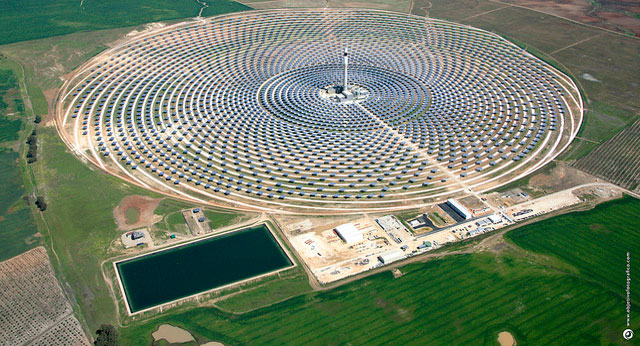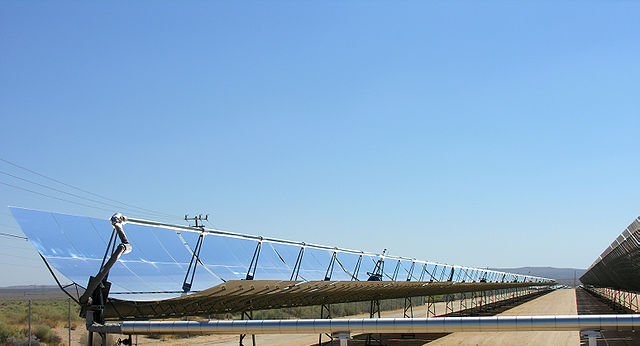Solar thermal systems
The energy in sunlight does not need to be converted to electricity, instead the sun’s photons can be used to make heat by heating water directly (or another fluid). A solar thermal power plant is essentially a nineteenth century technology based around the principle of heating water to make steam to turn a turbine to generate electricity. This is similar to a coal or nuclear power plant (Janardhan and Fesmire 2011). Although less direct than PV systems, solar thermal systems are more efficient averaging around 30% efficiency in converting the sun’s energy into electricity.
…one key advantage with solar thermal is that the heat can be stored to run the turbines well after the sun goes down. A large solar thermal plant in Spain does just that using molten salts as the storage medium.”
(Janardhan and Fesmire 2011: 24)
Solar thermal systems, sometimes also known as concentrated solar power (CSP) systems are far from mainstream and have only a limited distribution in sunny climates likes Spain and California in the US. In total there are 118 solar thermal power plants around the world (Desertec 2014). There are two main designs for solar thermal systems. In one instance a network of mirrors (often in a round formation) over a large area concentrate the sun’s energy onto a single point normally on a tower and water is heated to steam and routed to power a turbine linked to a generator to create electricity. In the other design trough-reflectors focus the sun’s energy onto fluid flowing in tubes parallel to the trough panels. The fluid is then passed through a heat exchanger where it heats water to make steam to turn a turbine linked to a generator. The parabolic trough reflectors move to follow the sun during the day and they heat the fluid in the tubes to 400OC. The fluid is then re-routed back to the reflectors and the cycle begins again.

Gemasolar Concentrated Solar Power Plant - Flickr / CC BY-NC-SA 2.0

Parabolic trough solar thermal electric power plant - Wikimedia / CC BY-SA 3.0
Because solar thermal projects use highly reliable technologies and produce electricity on a mass scale, it is likely they will become competitive with coal-fired power stations (Scientific American 2006). The largest solar thermal power plant to date (2015) is in the Mojave desert in California and has a power output a peak capacity of 354MW (Demirel 2012). Spain, in Europe, is the leader in this technology and has over 2GW of Concentrated Solar Power (CSP) connected to the grid.